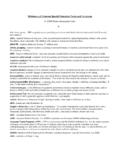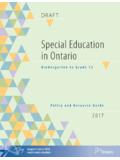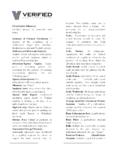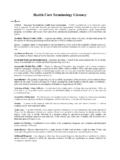Transcription of INCLUSIVE EDUCATION: AN EFA STRATEGY FOR ALL …
1 INCLUSIVE education : AN EFA STRATEGY FOR ALL CHILDREN SUSAN J. PETERS* WORLD BANK November 2004 The findings, interpretations and conclusions expressed in this report are entirely those of the author and should not be attributed in any manner to the World Bank, to its affiliated organiza-tions, to members of its Board of Executive Directors, or to the countries they represent. The report has gone through an external peer review process, and the author thanks those individuals for their feedback.
2 *Full document available online at *Susan J. Peters is an Associate Professor in the College of education , Michigan State University, East Lansing, Michigan, USA. She has been an educator and disability scholar for the past 20 years and has published in various international journals. She is the co-author and editor of two books: education and Disability in Cross-Cultural Perspective (NY: Garland Publishing. 1993) and Disability and Special Needs education in an African Context (Harare: College Press.)
3 2001). She may be contacted at 2 2 TABLE OF CONTENTS INCLUSIVE education : AN EFA STRATEGY FOR ALL CHILDREN glossary of Terms .. 4 I. 5 Background .. 6 II. INCLUSIVE education Practice: Lessons from the North .. 9 Background: .. 9 Best Practice in the United States and Canada .. 10 Best Practice in Europe and other OECD Countries .. 12 III: INCLUSIVE education Practice: Lessons from the South .. 13 INCLUSIVE education Framework .. 13 Inputs to INCLUSIVE education .. 15 Processes of INCLUSIVE education .
4 20 Outcomes of INCLUSIVE education .. 21 IV. Economic Issues: Financing and Mobilizing Cost-Effective Resources For INCLUSIVE education Programs .. 23 Background .. 23 Governmental Funding Formulas .. 23 Cross-Cutting Characteristics of Funding Models .. 25 Cost-Saving Measures to Resource INCLUSIVE 27 V. Legal Issues: Progress Towards the Right to INCLUSIVE 32 Background .. 32 Legislative and Policy Progress Toward INCLUSIVE education .. 33 Promoting Rights to INCLUSIVE education .. 34 VI: Policy/Practice Implications: Critical Issues In INCLUSIVE 37 Nine Critical Issues.
5 38 Conclusion: education for All Together .. 46 Annex 1: Sources for Information on Disability, INCLUSIVE education and Human Rights 48 3 3 Annex 2: Declarations .. 49 Chapter I: Introduction References .. 54 Chapter II: Lessons from the North References .. 56 Chapter III: Countries of the South References .. 58 Chapter IV: Economic Issues References .. 62 Chapter V: Legal Issues References .. 66 - The author wishes to thank and acknowledge the following individuals for their assistance with this report.
6 Carolyn Carpenter, American Institutes for Research William Divers, Michigan State University Pamela Dudzik, Disability Group/The World Bank Judy Heumann, Disability Group/The World Bank Christopher Johnstone, National Center for Educational Outcomes Shirley Miske, Miske Witt & Associates Penelope Price, Rehabilitation International Diane Prouty, American Institutes for Research Robert Prouty, The World Bank Diane Richler, Inclusion International Carlos Skliar, Universidade Federal do Rio Grande do Sul Sue Stubbs, International Disability & Development Consortium Leah Wasburn-Moses.
7 Michigan State University 4 4 glossary of Terms ADB Asian Development Bank AIR American Institutes for Research CAS Country Assistance STRATEGY CBR Community Based Rehabilitation CRC Convention on the Rights of the Child CERI Centre for Educational Research and Innovation CSIE Centre for Studies on INCLUSIVE education DESA Department of Economic and Social Affaires (United Nations) DPEP District Primary education Program DPI Disabled People s International DPO Disabled Peoples Organization EFA education for All ESCAP Economic and Social Commission for Asia and the Pacific ICF International Classification of Functioning and Disability ICIDH-2 International Classification of Functioning and Disability IDA International Disability Alliance IDEA Individuals with Disabilities education Act IE INCLUSIVE
8 education IEP Individualized education Program ISCED International Standard Classification of education MDG Millennium Development Goals NCERI National Centre on Educational Restructuring and Inclusion NCERT National Council for Educational Research and Training OECD Organization of Economic Co-operation and Development PER Program Effectiveness Review PIED Project Integrated education for the Disabled PRSP Poverty Reduction STRATEGY Paper SEN Special education Needs SIEDC Scheme for Integrated education of Disabled Children SNE Special Needs education UNICEF United Nations Children s Fund UNESCO United Nations Educational, Scientific and Cultural Organization UNCRC United Nations Convention on the Rights of the Child UPE Universal Primary education WHO World Health Organization 5 5I.
9 Introduction A dominant problem in the disability field is the lack of access to education for both children and adults with disabilities. As education is a fundamental right for all, en-shrined in the Universal Declaration of Human Rights, and protected through various international conventions, this is a very serious problem. In a majority of countries, there is a dramatic difference in the educational opportunities provided for disabled children and those provided for non-disabled children.
10 It will simply not be possible to realize the goal of education for All if we do not achieve a complete change in the situation. 1 Bengt Lindqvist, the United Nations Special Rapporteur on Human Rights and Disability The Dakar Framework for Action adopted a World Declaration on education for All (EFA) in 2000, which established the goal to provide every girl and boy with primary school education by 2015. It also clearly identified INCLUSIVE education (IE) as a key STRATEGY for the development of EFA.

















